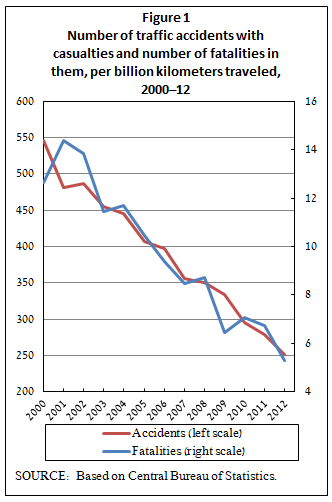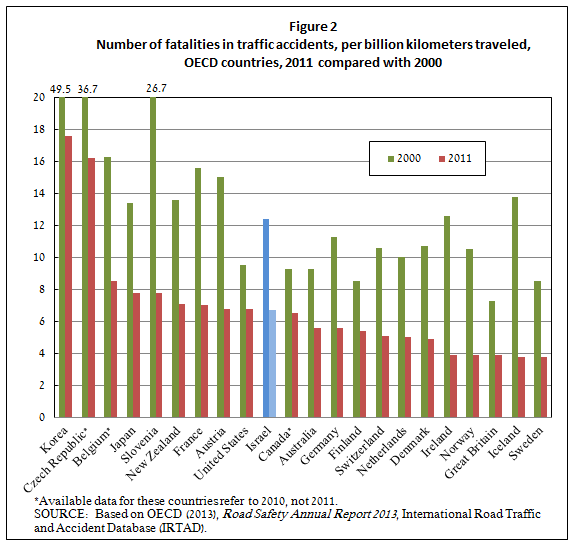![]() To view this press release as a Word document
To view this press release as a Word document
The effects of road infrastructure and law enforcement on traffic accidents on intercity roads in Israel[1]
Traffic accidents claim the lives of many people and cause significant economic damage. Since 2000, there has been a decline of about 40 percent both in the number of accidents with casualties and in the number of fatalities in them: In 2012, there were more than 12,000 accidents with casualties, and 263 people were killed. During the same period, there was a sharp decline in the number of accidents and in the number of fatalities per kilometer traveled (Figure 1). Since a similar process has occurred in other advanced countries, Israel’s position among them has remained almost unchanged—around the center of the ranking (Figure 2). The broad decline in the number of accidents and the number of fatalities can be attributed, inter alia, to an increase in vehicle safety levels and the use of safety features, as well as to an improvement in care of the casualties and in road infrastructure.
 |
|
 |
According to the Transportation Project Appraisal Procedure[2], the annual economic damage in Israel caused by accidents in 2008–10 was about NIS 15 billion (in 2012 prices)—about 2 percent of GDP. In 2012, the cost per fatality was about NIS 6.1 million, and the cost per critically injured person was about NIS 1.5 million.
This box assesses how road infrastructure and law enforcement contribute to a reduction in the number of accidents on intercity roads, based on a comprehensive database. The database includes (a) data on traffic accidents with casualties and on traffic volume, obtained from the Central Bureau of Statistics[3]; (b) data on the engineering features of road segments, from the Israel National Roads Company (formerly the Public Works Department (Ma’atz))[4]; (c) data on investment in road infrastructure taken from the State budget books and the Accountant General’s development plans; (d) data on traffic tickets issued by the Israel Police; and (e) weather data obtained from the meteorological stations throughout Israel. A complete analysis also requires data on the characteristics of drivers (“the human element”) and of the vehicles on the road segment, but these are not available to us because the existing data are not of sufficiently high quality or sufficiently up-to-date.[5]
The analysis relates to the number of accidents with casualties that occurred each month on intercity road segments[6] in 2005–09. Several models were estimated, with independent variables including traffic volume and the length of the road segment, engineering features, law enforcement and more, while taking seasonality into account. The estimates were conducted by various methods—examining how the number of accidents on road segments changes over time (panel) as dependent on the explanatory variables—and they generated similar results.
It was found that, assuming that all other variables remain constant, the elasticity of accidents with respect to distance traveled is 0.92 (an increase of 1 percent in distance traveled leads to an increase of 0.92 percent in the number of accidents)—similar to findings around the world.[7]
Concerning engineering features, it was found that the addition of one meter to the paved shoulders reduces the number of accidents by about 15 percent; a physical divider between traffic lanes in opposite directions reduces the number of accidents by about 32 percent; and a sharp curve in a road increases the number by about 21 percent.[8] These findings are consistent with the results obtained around the world. It was also found that the engineering features in the Center region of the country are better than those in the periphery.
Road works increase the number of accidents by about 14 percent. The Transportation Project Appraisal Procedure does not explicitly relate to this in calculating the cost of an infrastructure project, which may cause an over-estimation of how worthwhile it is, in particular taking into account the fact that infrastructure works last for a prolonged period.
An assessment of the ranking of the standardized number of accidents per kilometer traveled—an index that reflects the probability of an accident—shows that among the road segments at the top of the ranking (“red roads”), there is a greater representation by secondary segments with less traffic (for example in the Golan Heights), and there is a lower representation of roads in the south of the country. All of the engineering features of these red roads are considerably inferior compared to the other road segments.
Law enforcement is measured by the number of automatic traffic tickets (speed cameras) and/or manual traffic tickets issued on a road segment in the present and the recent past; and on the basis of an approximation of police presence, calculated based on the number of hours during which manual traffic tickets were issued. Similar to other studies in the field, we do not have information on police activity that did not end in the issuing of a ticket. The impact of enforcement is identified by the extent to which the number of tickets in a road segment changes over time, compared to the average multi-year level of law enforcement. (This level is dependent on the basic risk characterizing the segment, as depicted in its fixed effect.)[9] As such, the estimate cannot indicate the impact of the country-wide level of enforcement. It has not been found that change in police enforcement has an impact on the number of accidents, similar to a previous study conducted in Israel.[10] The findings from around the world are mixed.
In summation, it was found that the probability of traffic accidents on intercity roads declines significantly due to a number of engineering features—including wide paved shoulders and a divider between opposing directions of traffic—and increases due to a sharp curve or road works. It was not found that change in police enforcement has an impact on the probability of accidents, but we cannot draw a conclusion from this on the effect of law enforcement level.
We further note in conclusion that it is important to establish a comprehensive national traffic accident database. Such a database will make it possible to study the causes of accidents and to formulate effective policy concerning them, as it will be able to assist, for example, in more efficient allocation of investments in infrastructure and police enforcement.
[1] Based on Brown, L., Zussman, N. and Sharabany, R. (forthcoming), “The Causes of Traffic Accidents on Intercity Roads in Israel,” Bank of Israel Research Department, Jerusalem.
[2] The State of Israel (2012), The Transportation Project Appraisal Procedure (Nohal Prat) 2012: Transportation Project Appraisal Guidelines, Jerusalem.
[3] The Central Bureau of Statistics measures traffic volume on road segments once every year or two, for a week. The study upon which the box is based estimate monthly traffic volume based on these data, after taking seasonality into account. Such an estimate is preferable to using raw data, as customary in many countries and in Israel, both due to the seasonality adjustment and due to the use of monthly (instead of yearly) frequency.
[4] The analysis included about 570 intercity road segments.
[5] A survey of travel habits has not been conducted since 1996–97.
[6] The analysis does not include accidents that occurred at junctions, since those intersections have unique engineering features compared to road segments. In addition, the analysis includes only Sundays to Thursdays, because travelers have different characteristics on Fridays and Saturdays due to the lower volume of distance traveled to the work place (commuting).
[7] Elvik, R., Hoye, A., Vaa, T. and Sorensen, M. (2009), The Handbook of Road Safety, Emerald Group Publishing Limited, Second Edition, UK. Other findings from around the world which are mentioned below are also taken from the same source.
[8] No significant effect was found for lane width, an outside guardrail, a sharp decline, or the maximum permitted speed.
[9] The method of identification is based on the assumption that police enforcement does not react in the short term to the number of accidents in a segment. To the extent that this assumption is not valid (there is an “endogeneity problem”), the results of the estimates will indicate that enforcement has a lesser impact on the number of accidents than was actually the case.
[10] Gafni, D. (2000), An Econometric Analysis of Traffic Accidents in Israel, PhD thesis, Hebrew University, Jerusalem.